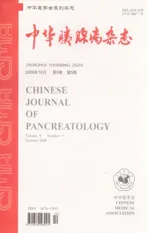外周血K-ras基因突变检测在胰腺癌诊断中的应用
2009-11-27林寒李兆申高军龚燕芳金晶
林寒 李兆申 高军 龚燕芳 金晶
·论著·
外周血K-ras基因突变检测在胰腺癌诊断中的应用
林寒 李兆申 高军 龚燕芳 金晶
目的检测胰腺癌患者外周血K-ras基因第12、13密码子突变,探讨其对胰腺癌的诊断价值。方法选取经病理证实的胰腺癌患者54例以及健康志愿者33例。抽取全部实验者外周血标本,抽提循环中的DNA,应用肽核酸钳制实时定量PCR法检测K-ras基因突变,并分析其与患者临床病理参数的相关性。结果54名胰腺癌患者中,40例(74.1%)外周血标本可检测出K-ras基因第12或13密码子突变。33名健康志愿者外周血标本无一例检出K-ras基因突变。外周血中K-ras基因的突变与患者年龄、淋巴血管侵犯、肿瘤分化程度、肿瘤临床分期、CA19-9水平有关(Plt;0.05),而与患者性别、肿瘤部位、肿瘤大小及病理类型无关。结论肽核酸钳制实时定量PCR法检测外周血K-ras基因突变的敏感性高。外周血K-ras基因突变的检出提示肿瘤具有高侵袭性,可能预后不良。
胰腺肿瘤; 肽核酸类; K-ras基因; 血液循环
研究表明,75%~100%的胰腺癌发生K-ras基因第12或13密码子突变[1]。临床可获得的检测标本包括手术切除的肿瘤组织、内镜超声引导下的细针穿刺活检组织或细胞以及胰液、十二指肠液、外周血及粪便等等。其中肿瘤组织的K-ras基因突变阳性检出率最高[2],其次是胰液[3],但组织标本为有创性检查,胰液收集操作复杂,部分患者无法耐受,而外周血及粪便DNA的检测具有简便、可重复性强、无创伤等优点。既往有研究认为,外周血及粪便中的K-ras基因检测阳性率较低,特异性不高,考虑原因与外周血及粪便DNA的抽提技术,以及K-ras基因检测方法不够灵敏有关。
本室前期建立了肽核酸(peptide nucleic acid,PNA)钳制实时定量PCR法检测K-ras基因第12、13密码子突变[4],敏感性高达0.001%。本文应用该法检测胰腺癌患者外周血K-ras基因突变,探讨其对胰腺癌的诊断价值。
材料与方法
一、临床标本
选取2006年至2007年上海长海医院住院的经病理证实的胰腺癌患者54例,经过患者及家属知情同意及伦理委员会通过后,抽取患者外周血,根据常规血细胞DNA抽提方法[5]抽提循环血的DNA,置-20℃保存。以33例健康志愿者血标本为对照。
二、对照质粒的构建
根据文献报道,BxPC3细胞含野生型K-ras基因,第1外显子第12、13密码子序列为GGTGGC,PANC1细胞K-ras基因第12密码子突变,序列为GATGGC,SW1990细胞K-ras基因第13密码子突变,序列为GGTGAC。本室从中国科学院细胞所购得以上3种胰腺癌细胞株。常规复苏、培养。收集细胞、抽提细胞DNA。用PCR方法分别扩增出K-ras野生型及突变型的DNA片段,以pTA2质粒为载体,分别构建出野生型、第12密码子突变型及第13密码子突变型质粒,作为PCR检测的阴性、阳性对照。
三、K-ras基因第12、13密码子突变检测
应用我室前期建立的PNA钳制实时定量PCR法检测K-ras基因第12、13密码子突变。引物序列:上游,5′-TACTGGTGGAGTATTTGATA-3′;下游,5′-CAAGATTTACCTCTATTGTT-3′。PNA序列:NH2-CCTACGCCACCAGCTCC-HAc。反应条件:95℃预变性1 min,95℃变性15 s,70℃ PNA结合10 s,60℃引物退火及延伸1 min。扩增40循环,在每一循环的60℃步骤末收集荧光信号。反应结束后进行融解曲线分析:95℃持续15 s,冷却至65℃保持1 min,并以0.3℃/s的速度逐渐升温至95℃持续15 s。通过仪器自带软件自动分析出Ct值。对于PNA抑制下无扩增的模板,进行常规PCR扩增,确定样品中DNA模板的完整性。每一份样品检测3次。
根据前期的实验结果[4],野生型与突变型基因的融解温度(tm值)分别为(83.5±0.5)℃及(80.8±0.6)℃。当tm值为(80.8±0.6)℃时,判定标本含突变型基因,当tm值为(83.5±0.5)℃时,标本含野生型基因。
四、统计学分析
K-ras基因突变与患者临床病理参数的相关性行χ2检验。所有的统计学分析均使用SPSS13.0软件,P值lt;0.05认为有统计学意义。
结 果
一、外周血DNA的K-ras基因突变率
54例胰腺癌血液标本中有40例K-ras基因发生突变,突变率为74.1%。突变拷贝数占总拷贝数的0.15%~12.04%。健康志愿者均为野生型K-ras。
二、K-ras基因突变与临床病理参数的关系
胰腺癌患者外周血中K-ras基因的突变与患者年龄、淋巴及血管侵犯、肿瘤分化程度、肿瘤临床分期、血CA19-9水平等有关,而与患者性别、肿瘤部位、肿瘤大小及病理类型无关(表1)。

表1 K-ras基因突变与临床病理参数间的相关性
讨 论
近年研究表明,许多恶性肿瘤细胞内的DNA会出现在血清或血浆之中。Leon等[6]及Shapiro等[7]检测了正常人及消化道良、恶性疾病患者的血浆游离DNA水平,正常人血浆DNA含量平均是13 ng/ml,良、恶性疾病患者分别是118 ng/ml和412 ng/ml,胰腺癌患者可高达650 ng/ml。血浆中突变的基因型多与原发灶的突变类型一致,猜测可能是血循环中破碎的肿瘤细胞释放的DNA[8]。因此,通过检测外周血DNA的基因型或突变来诊断肿瘤是一个值得探讨的领域。
K-ras基因的点突变是与胰腺癌发生、发展关系最为密切的癌基因之一[9-10]。K-ras基因点突变检测对于胰腺癌诊断是十分有意义的。既往研究显示,外周血K-ras基因突变检测的特异性较高,但敏感性却差强人意[11-12]。Rodolfo等[13]用传统的RFLP-PCR同时检测胰腺癌患者胰腺组织及血液标本,其中肿瘤组织的K-ras基因突变率高达70%,而相应的外周血DNA的K-ras基因突变率却为0。Dabritz等[14]报道的特异性探针联合PNA钳制PCR法检测血浆DNA中K-ras基因突变率亦仅为36%。本组结果显示,应用PNA钳制实时定量PCR法检测胰腺癌患者外周血DNA中K-ras基因第12、13密码子突变,突变率高达74.1%,而健康人中无一例K-ras基因突变。这一结果得益于本实验应用的检测方法。传统的RFLP-PCR等检测方法敏感性较低;选用针对K-ras基因第12密码子的Taqman探针进行PNA钳制实时定量PCR法检测,虽然特异性高,但是一种探针只能检测第12或13密码子的一种类型的突变,而在同一肿瘤标本中也可能存在多种类型的突变[15];本实验选择SYBR Gree Ⅰ作为荧光染料,可同时检测第12、13密码子任意一种突变,从而提高了检测的敏感性。本实验结果还显示,外周血中K-ras基因的突变与年龄、淋巴血管侵犯、肿瘤分化程度、血CA19-9水平具有显著的相关性,提示外周血K-ras基因突变在一定意义上表示肿瘤具有高侵袭性,是预后不良的因素之一。
[1] Cerny WL,Mangold KA,Scarpelli DG.K-ras mutation is an early event in pancreatic duct carcinogenesis in the Syrian golden hamster.Cancer Res,1992,52:4507-4513.
[2] Tada M,Omta M,Ohto M,et al.Clinical application of ras gene mutation for diagnosis of pancreatic adenocarcinoma.Gastroen-terology,1991,100:233-238.
[3] Kimura W,Zhao B,Futakawa N,et al.Significance of K-ras codon 12 point mutation in pancreatic juice in thediagnosis of carcinoma of the pancreas. Hepatogastroenterology,1999,46:532-539.
[4] 林寒,李兆申,高军,等.应用肽核酸钳制PCR技术检测胰腺癌K-ras基因突变.第二军医大学学报,2009,30:754-758.
[5] Tada M,Komatsu Y,Kawabe T,et al.Quantitative analysis of K-ras gene mutation in pancreatic tissue obtained by endoscopic ultrasonography-guided fine needle aspiration:clinical utility for diagnosis of pancreatic tumor.Am J Gastroenterol,2002,97:2263-70.
[6] Leon SA,Shapiro B,Sklaroff DM,et al. Free DNA in the serum of cancer patients and the effect of therapy.Cancer Res,1997,37:646-650.
[7] Shapiro B,Chakrabarty M,Cohn EM,et al. Determination of circulating DNA levels in patients with benign or malignant gastrointestinal disease. Cancer,1983,51:2116-2120.
[8] Castells A,Puig P,Mora J,et al.K-ras mutations in DNA extracted from the plasma of patients with pancreatic carcinoma:diagnostic utility and prognostic significance.J Clin Oncol,1999,17:578-584.
[9] Hingorani SR,Petricoin EF,Maitra A,et al.Preinvasive and invasive ductal pancreatic cancer and its early detection in the mouse.Cancer Cell,2003,4:437-450.
[10] Hirai H,Okabe T,Anraku Y,et al.Activation of the c-K-ras oncogene in a human pancreas carcinoma.biochem biophys res.Commun,1985,127:168-174.
[11] Mulcahy HE,Lyautey J,Lederrey C,et al.A prospective study of K-ras mutations in the plasma of pancreatic cancer patients.Clin Cancer Res,1998,4:271-275.
[12] Li W,Zhu T,Guan KL.Transformation potential of Ras isoforms correlates with activation of phosphatidylinositol 3-kinase but not ERK.J Biol Chem,2004,279:398-406.
[13] Rodolfo M,Alessandra M,Patrizio P,et al. Low correspondence between K-ras mutations in pancreatic cancer tissue and detection of K-ras mutations in circulating DNA.Pancreas,2006,32:171-177.
[14] Dabritz J,Preston R,Hanfler J,et al.Follow-up study of K-ras mutations in the plasma of patients with pancreatic cancer.Pancreas,2009,38:534-541.
[15] Ernst BP,Wilichowski E,Wagner M,et al.Deletion screening of mitochondrial DNA via multiprimer DNA amplification.Mol Cell Probes,1994,8:45-49.
2009-04-23)
(本文编辑:屠振兴)
Screeningforpancreaticcancerbypeptidenucleicacid-mediatedone-stepK-rasmutationdetectionassay
LIN Han, LI Zhao-shen, GAO Jun, GONG Yan-fang, JIN Jing.
Department of Gastroenterology, Changhai Hospital, Second Military Medical University, Shanghai 200433, China
LIZhao-shen,Emailzhsli@81890.net
ObjectiveTo investigate the diagnostic value of determination of the genotypes in codon 12 and 13 of K-ras oncogene in blood samples of patients with pancreatic carcinoma (PC).MethodsBlood samples were obtained from 54 patients with pathologically confirmed PC, and 33 healthy controls. The DNAs were obtained in these samples, and then genotype of K-ras mutation was detected by using the PNA-clamping real-time quantitative PCR. Then the correlation between the K-ras genotypes of blood DNA and the clinical characteristics was analyzed.ResultsK-ras mutations were found in 74.1% (40/54) of patients with PC. There was no such mutation in control samples. The mutations of K-ras was associated with age, lymph node and vessel invasion, poorly differentiated tumor, CA19-9, while it was not associated with sex, tumor location, size of tumor, clinical staging and pathological type.ConclusionsThe one-step method was highly sensitive for detecting K-ras mutation in blood samples. Detection of circular blood cells harboring K-ras mutation suggested the tumor was highly invasive with poor prognosis.
Pancreatic neoplasms; Peptide nucleic acids; K-ras gene; Blood circulation
10.3760/cma.j.issn.1674-1935.2009.05.008
200433 上海,第二军医大学长海医院消化内科
李兆申, Email:zhsli@81890.net
